
Electrical Quantum States Translated to Optical Ones
SANTA BARBARA, Calif., Sept. 24, 2013 — Using a piezoelectric optomechanical crystal to generate a strong optical response, a UC Santa Barbara team has demonstrated a nanomechanical interface between optics and electronics, the first — and arguably the most challenging — step toward enabling ultrafast, quantum-encrypted communications and fundamental quantum physics studies.

A scanning electron micrograph of the UCSB device showing the mechanically suspended optomechanical crystal (blue) with electrodes (yellow) and the photonic circuit (red). Courtesy of Joerg Bochmann and Amit Vainsencher, UCSB.
To improve the security of digital information transfer, scientists are working to translate electrical quantum states to optical quantum states in a way that would enable quantum-encrypted communications that go far beyond today's high-speed Internet, in which electrical signals are converted to light, sent through optical fibers, then converted back to electricity on the other end. The team created a nanomechanical transducer that provides strong and coherent coupling between the types of signals.
"There's this big effort going on in science now to construct computers and networks that work on the principles of quantum physics," said lead author Jörg Bochmann, a postdoctoral scholar in UCSB's department of physics. "And we have found that there actually is a way to translate electrical quantum states [microwaves] to optical quantum states [photons]."
In their paper, published Sept. 15 in Nature Physics (doi: 10.1038/nphys2748), the researchers outline the concept and present a prototype device, which uses an optomechanical crystal used in a piezoelectric material in a way compatible with superconducting qubits. Operating the device at the single-phonon limit, the scientists generated coherent interactions between electrical signals, very high frequency mechanical vibrations and optical signals.
"The controlled interactions between electrical signals, phonons and optical photons realized in this device provide an excellent outlook for quantum electro-optomechanics," the researchers said in their paper.
The transducer prototype has not yet operated in the quantum realm, they said, but that is the next step.

A schematic of electro-optomechanical transduction in the piezoelectric optomechanical crystal. Courtesy of Jörg Bochmann and Amit Vainsencher, UCSB.
"In this paper, we're characterizing the system using classical electrical and optical signals and find that the essential parameters look very promising," Bochmann said. "In the next step, we would have to actually input quantum signals from the electrical side and then check whether the quantum properties are preserved in the light."
The prototype transducer is fully compatible with superconducting quantum circuits and is well suited for cryogenic operation, they said.
“The coupled dynamics of the system should be the same at low temperatures as in our room-temperature measurements, albeit with a lower thermal background," said co-author Andrew Cleland, a professor of physics and associate director of the California Nanosystems Institute at UCSB. "Genuine quantum features and nonclassical mechanical states will emerge when we couple a superconducting qubit to the transducer.
“We believe that combining optomechanics with superconducting quantum devices will enable a new generation of on-chip quantum devices with unique capabilities, as well as opening an exciting pathway for realizing entangled networks of electronic and photonic quantum systems," Cleland said.
The devices were made at the UCSB Nanofabrication Facility, and the work was supported by the DARPA project ORCHID (Optical Radiation Cooling and Heating in Integrated Devices).
For more information, visit: www.ucsb.edu
Published: September 2013